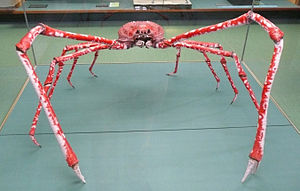Japanese giant crab
| Japanese giant crab | ||||||||||||
|---|---|---|---|---|---|---|---|---|---|---|---|---|

Japanese giant crab ( Macrocheira kaempferi ) in the Stralsund Marine Museum |
||||||||||||
| Systematics | ||||||||||||
|
||||||||||||
| Scientific name of the genus | ||||||||||||
| Macrocheira | ||||||||||||
| de Haan , 1839 | ||||||||||||
| Scientific name of the species | ||||||||||||
| Macrocheira Kaempferi | ||||||||||||
| ( Temminck , 1836) |
The Japanese giant crab (高 脚 蟹 takaashigani, dt. "Long-legged crab"), Macrocheira kaempferi , is the largest living cancer and at the same time the largest living arthropod .
features
The Japanese giant crab has a mass of up to 13.6 kilograms (measured on an individual in the Scheveningen Sea Life Center ), according to dubious data possibly even up to 19 kilograms. Her body has a diameter of around 37 centimeters, from the tip of one leg to the other it measures up to 3.7 meters when stretched out. The body is rounded and covered with blunt growths, the legs are extremely long and thin.
distribution
Japanese giant crabs are found only in the Pacific , especially around Japan . There they live at depths between 300 and 400 meters at temperatures between 11 ° C and 14 ° C. During the spawning season, the giant crabs migrate to shallower waters. Further findings are available for Taiwan , but where they do not reach the same size.
Multiplication and development
The males are larger than the females and have larger pincers. The males carry the sperm with them in spermatophores ; during mating it is transmitted through the gonopods . The female carries the fertilized eggs with her on her body, where they are held in place by a glue from the setae .
The newly hatched zoea are small, transparent, round and legless organisms that swim on the surface of the sea. After several moults, the extremities begin to form and the body takes shape. This continues during the subsequent moults until the animals are fully grown.
Way of life
Japanese giant crabs walk very slowly across the ocean floor on their long legs in search of food.
food
They are omnivores, eat carrion, plants (which they scrape from the sea floor) or other animals such as mollusks whose shells they open to get to the meat. To camouflage themselves from predators (e.g. squid ), they put sponges and similar marine animals on their bodies.
Initial description
The Japanese giant crab was discovered by the German doctor and explorer Engelbert Kaempfer at the end of the 17th century; it was first described in 1836 by Coenraad Jacob Temminck under the scientific name Maja kaempferi . Only later was it assigned to the genus Macrocheira . The species name honors the discoverer Kaempfer. One male and one female animal of this species can be seen prepared in the witch mayor's house in Kaempfer's hometown Lemgo .
proof
Web links
Individual evidence
- ^ Smithsonian Scientific Series , p. 173, 10th edition (1931). Smithsonian Institution , 1929. Retrieved February 12, 2012. "The giant among the crustaceans is of course [...] Macrocheira kaempferi" ["The giant among Crustacea is, of course, Macrocheira kaempferi "]
- ↑ Craig R. McClain, Meghan A. Balk, Mark C. Benfield, Trevor A. Branch, Catherine Chen, James Cosgrove, Alistair DM Dove, Lindsay C. Gaskins, Rebecca R. Helm, Frederick G. Hochberg, Frank B. Lee , Andrea Marshall, Steven E. McMurray, Caroline Schanche, Shane N. Stone, Andrew D. Thaler (2015): Sizing ocean giants: patterns of intraspecific size variation in marine megafauna. PeerJ 3: e715 doi : 10.7717 / peerj.715 (open access)
- ↑ Giant spider crab . In: The Two Oceans Aquarium . Retrieved January 24, 2012.
- ^ Life on the deep sea floor . In: Natural History Museum . Retrieved February 10, 2012.
- ↑ JF Huang, HP Yu, M. Takeda (1990) Occurrence of the Giant Spider Crab, Macrocheira kaempferi (Temminck, 1836) (Crustacea: Decapoda: Majidae) in Taiwan. Bulletin of the Institute of Zoology, Academia Sinica 29: 207-212.

